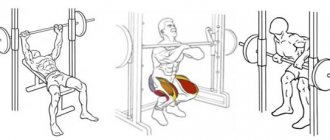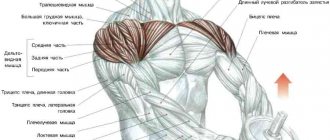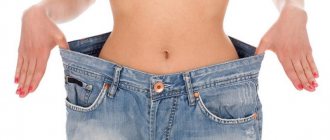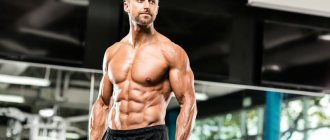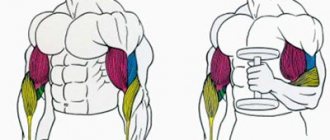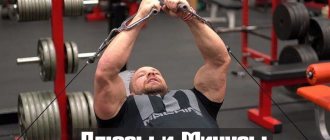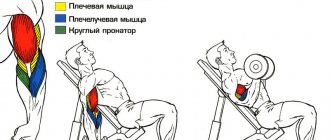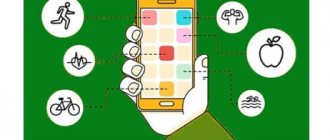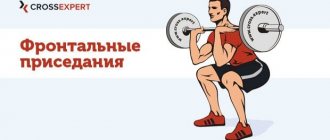Author: Timko Ilya - the ruler of the entire site and fitness trainer | more details >> Rod. 1984 Trained since 1999 Trained since 2007. Author and creator of the site tvoytrener.com. CCM in powerlifting. Champion of Russia and South Russia according to AWPC. Champion of the Krasnodar region according to IPF. 1st category in weightlifting. 2-time winner of the Krasnodar Territory championship in t/a. Author of more than 700 articles on fitness and amateur athletics. Author and co-author of 5 books.
Place in the author rating:
out of competition
(become an author) Date: 2012-05-29 Views: 209,955 Rating: 5.0
| All articles by the author >> | Medals articles >> |
Articles are loading...
| Article medals: | more than 100 thousand views |
Why medals are given to articles:
| Bronze medal: | |
| 1. The article is in the TOP 100 2. The article has more than 3. The article has more than 100 | |
| Silver medal: | |
| 1. The article is in the TOP 50 2. The article has more than 3. The article has more than 500 | |
| Gold medal: | |
| 1. The article is in the TOP 10 2. The article has more than 1 3. The article has more than 1,000 | |
Main muscles - biceps Additional - no (with correct technique) Difficulty - easy
Content
- 1 Arm training in the gym
- 2 Introduction to arm muscles
- 3 The pleasure of strong hands
- 4 Features of arm training
- 5 How to avoid mistakes when developing arm muscles in the gym
- 6 Exercises for arm training 6.1 Standing barbell curls
- 6.2 Reverse alternating curl with dumbbells
- 6.3 Concentrated arm curl
- 6.4 Bending arms on the machine
- 6.5 Triceps Pulldown
- 6.6 Arm extension back
- 6.7 Push-ups from a bench with support at the back
- 6.8 Press down on the machine
- 6.9 Wrist flexion and reverse wrist flexion 6.9.1 Wrist flexion
- 6.9.2 Reverse wrist flexion
Scott curls
All movements in the simulator are similar to those performed with a barbell, due to the fact that the elbows are in front of the body; the long head of the biceps receives a reduced load, due to the fact that the initial position of the body does not allow it to fully stretch, but the short one will “plow” for two.
Exercise in the Scott simulator perfectly isolates the biceps, preventing violation of the movement technique, which is caused by tightly pressed hands on the outside.
All this eliminates the possibility of cheating and, on the contrary, provides an excellent chance to perform a drop set, and performing one-arm curls allows you to use forced repetitions and negatives.
Arm training in the gym[edit | edit code]
Main articles:
Biceps - exercises and training features and Triceps - exercises and training features Arm muscles
To begin with, we want to tell you one entertaining and absolutely true story. One day Liz met a woman from New York who decided to go to the gym only because of her new hairstyle. She explained that her “personal hairdresser” advised her to change her styling method: instead of using a hairdryer, she styled her hair with her hands. And in order to give her hair a beautiful shape, this woman had to bend and straighten her arms many times. “I couldn’t even imagine that my hands were so weak,” she complained to Liz. “To make my hair look great, I just had to start lifting weights.” How do you like it? By the way, you need strong hands not only for hairstyles. Therefore, in this chapter we will talk in detail about how to develop arm muscles.
What muscles work
In standing dumbbell biceps curls, the brachioradialis and brachialis muscles work the biceps brachii muscle (biceps) is included in the work Dumbbell curls for biceps are also performed in a sitting position, the technique does not change, the only thing is that the body on the vertical bench will be fixed and will not allow the body to sway. Both options can be performed with both hands or alternately.
Getting to know the arm muscles[edit | edit code]
Main article:
Arm muscles
Let me introduce you to the biceps
.
These are the biceps muscles located on the front of the upper arms. Looking into the gym, you will probably see people who, thinking that no one is seeing them, bend their arms in front of the mirror and admire these very muscles. The main job of the biceps is to curl your arms. Therefore, the main movement of all biceps exercises is flexion
.
Directly opposite the biceps are the triceps
. These triceps muscles run at the back of your upper arms. Like many other muscle groups, biceps and triceps always work together. When you tense your biceps, your triceps relax and your arms flex. Conversely, when you tighten your triceps, your biceps relax and your arms extend. Therefore, it is extremely important to maintain a balance of strength between these muscles, preventing some from being more powerful than others. This is why you should do both biceps and triceps exercises regularly.
There is another muscle group in your hands that allows you to move your wrists. To save you from complicated names, we will simply call them the muscles of the forearm. Thanks to these muscles, you can raise and lower your wrists, make rotational movements, tilt them to the right and left, and turn your palms. The most important task of the forearm muscles is, perhaps, to stabilize the wrist joint. If your forearm muscles are weak, your wrists may bend at the most inopportune times (for example, when you are holding a 50 kg barbell over your chest). Weakness in these muscles also means that you can't firmly grip an object like a baseball bat, a stubborn weed, or a can of pineapple. In addition, it opens the door for the development of carpal tunnel syndrome
- inflammation of the nerve endings in the lower part of the arm.
What you can work with in the gym
Any normal gym should provide its clients with at least the minimum necessary equipment: a barbell with weights and dumbbells. I'm not even talking about the Scott bench, special block exercise machines and the EZ bar. If the gym where you work out has all or most of the above, then I congratulate you - with hard work you will get voluminous and sculpted biceps, just like in the video.
The biceps muscles of the arms can be pumped up with exercises that focus on them, as well as together with pumping up the back: during bent-over barbell rows, pull-ups on the horizontal bar, rows of the upper and lower blocks. And in general, with any exercises to develop the latissimus dorsi muscles, you can stimulate your biceps to grow - they work “in pairs”. Do you know all the secrets to growing biceps? But be prepared that sooner or later there will be a shortage of such exercises - you will still have to use the basic ones.
What you can work with at home
As you already understand, you can also work with dumbbells at home and use the above exercises in front of a mirror. Also, pumping up your biceps at home involves doing pull-ups on a horizontal bar with a reverse grip, on one arm, or with your wrists turned.
A rubber expander can be a convenient exercise machine for biceps - like dumbbells, it takes up little space.
If you have a barbell at home, you are lucky. If you don’t have a single shell, but you want to look pumped up, it doesn’t matter! Can you find five or six liter plastic containers? Fill them with water, or even better, sand, and exercise for your health by performing various arm flexions/extensions while standing. The need for invention is tricky, so go for it.
The pleasure of strong hands[edit | edit code]
Since in everyday life we almost constantly do something with our hands, their movements have long been taken for granted by us. Meanwhile, paying special attention to their muscles in the gym can provide many benefits.
- Real life benefits.
Your arms are the link between your upper body and the rest of the world. If they are weak, then the larger muscles of the back and chest will not be able to work to their full potential. After all, in fact, your overall strength directly depends on your weakest link. For example, performing a high pulldown primarily requires a person to have strong back muscles. However, weak biceps will significantly limit your ability to perform this exercise. With strong triceps, you can develop your chest muscles more effectively with specific exercises such as push-ups or bench presses.
Strong forearms and wrists are essential for many strength training exercises as well as activities outside the gym. They help you play golf, crack nuts, shuffle playing cards, or work on a computer keyboard without strain or pain.
- Preventing injuries.
Strong arms protect your elbows from injury.
Carry a heavy briefcase in your hand, and sooner or later your elbow will begin to ache. Having strong arm muscles, you can carry a briefcase for many hours without feeling any pain. In addition, you will be much less likely to get so-called tennis elbow
or radiobrachial bursitis - inflammation of the elbow joint. Strong arms also minimize discomfort or injury when lifting barbells, dumbbells, or simply removing plates from a rack. Among other things, strong forearm muscles help prevent carpal tunnel syndrome. But this unpleasant inflammation often occurs from the most ordinary repetitive movements. For example, it can be caused by prolonged typing on the keyboard, scanning items in a supermarket, or working with a computer mouse.
- Feel good factor.
We always tend to associate strong, sculpted biceps with masculine strength. As for women, the judges have not yet made a final verdict in this case. Public opinion cannot come to an agreement about which hands women prefer to have, strong or weak. Be that as it may, strong arms help you enjoy life more, and defined muscles look healthier. People's judgments about what muscles should be present in both sexes often depend on fashion trends and change with it. But no one will dispute the fact that it is always good to be strong and healthy, feeling confident.
Working muscles
- The main muscle worked is the biceps brachii. This is the biceps, which is what we want to develop when we do a lot of lifts and strive to perform more repetitions with impressive weight;
- The brachialis and brachyradialis, the brachialis and brachioradialis muscles, help with movement. The first is responsible for the size of the forearms in the aesthetics of the body, the second – as if “raises” the biceps, if it is qualitatively hypertrophied;
- The front deltoids act as stabilizers. They help balance weight during movement and are statically tense. The triceps are partially activated as stabilizers if the dumbbells are lowered slowly enough
This exercise is effective for athletes of any level of training. It can be performed in two variations of palm placement:
Supination is the turning of the hand outward.
- With the palm facing the stomach;
- Supinated lift, that is, palms up
There are also several variations of the starting position:
- Simple standing rise;
- Movement with the forearm resting on the thigh while sitting (concentrated lifting);
- Lifting while sitting on a bench;
- Lifting while sitting on an inclined bench;
- Raising with dumbbells "hammer"
Features of hand training[edit | edit code]
The arm muscles are smaller than the muscles of the chest, back and shoulders. Therefore, you can spend much less time on their development, and get the result no worse. If you are aiming to make your arms stronger and more beautiful, it will be quite enough to do 1-3 approaches for each arm. If you want to get particularly strong arms with large and defined muscles, then you will have to perform 5-8 approaches.
Spend equal time on biceps and triceps exercises. If one of these muscle groups is much stronger than the other, you risk an elbow injury.
Of course, the psychology of people involved in strength training is not always explainable. In the meantime, if you prefer to exercise one muscle group over another, we want to give you some tips. Start with exercises on your less favorite muscles to avoid the temptation to skip them altogether. If you train on a weekly schedule, you can work on different muscle groups on different days.
Always do arm exercises after training your back and chest. Otherwise, your arms will become too tired and you won't be able to effectively work the larger muscles. The forearms should be the last muscles in your upper body that you work before you hit the shower.
Bending arms on the upper block
This exercise for pumping up the biceps is performed in a crossover, or rather on the upper blocks. To perform it correctly, it is necessary to ensure that the elbows are still, and when extending, the arms must be fully straightened so that the biceps are well stretched for further powerful contraction.
To stretch your biceps more strongly when extending your arms, rotate your grip to the outside; the stronger the rotation, the stronger the stretch, which is an important point for increasing the desired “cans.”
Also, do not forget to hold for a second when bending your arms to maximum to achieve peak contraction and muscle failure.
Elbows must be kept at shoulder level, not allowing them to drop under load.
How to avoid mistakes when developing arm muscles in the gym[edit | edit code]
When performing arm exercises, some people move so awkwardly that it immediately catches your eye, as if they are dancing in a spotlight. Therefore, always follow these tips while training.
- Don't cheat.
If, when lifting a barbell or dumbbells, you bend your torso, know that in this case it is not your arms that are working, but your whole body. Rocking your torso back and forth is a recipe for lower back injuries. I wonder what your friends will think of you if you tell them that you strained your lower back while doing exercises for your arm muscles.
- Don't skip forearm exercises.
As already noted, it is much more pleasant to have well-developed forearm muscles.
- Be careful with your elbows.
In the descriptions of the exercises in this chapter, you will more than once come across the phrase about extension and straightening of the arms. However, this does not mean that you should lock your elbows in a completely straight position.
- Keep your elbows still.
If you turn your elbows to the sides during strength exercises for biceps and triceps, then, of course, you can lift more weight. However, this only works because you gain in strength due to greater leverage. This doesn't make your arms stronger. Perhaps when you do biceps exercises like the dumbbell reverse curl (described a little later), you will also tend to extend your arms and elbows forward. Naturally, since this movement helps lift the weight, you will not be able to avoid it completely. But try to at least keep it to a minimum.
Working muscles
Biceps brachii, brachialis, indirectly on the muscles of the forearm.
The biceps training machine is similar in appearance to a Scott bench, with a handle movably attached to its base, which has the ability to move along a strictly specified amplitude around the axis of rotation. There are a lot of varieties of this simulator, each gym has its own, but the meaning of their work is the same.
Exercises for training arms[edit | edit code]
Below we will look at the following exercises for arm muscles in the gym.
- Exercises for biceps
: standing barbell curl, reverse alternating dumbbell curl, concentration curl and machine curl.
- Triceps exercises
: triceps pull-downs, back extensions, back push-ups and machine down presses.
- Forearm exercises
: wrist curl and reverse wrist curl.
Standing barbell curl[edit | edit code]
Rice. 2. Standing barbell curl. Don't rock back and forth to lift the barbell Main article:
Standing barbell curl
This exercise is aimed at developing and strengthening the biceps in the gym.
Be especially careful if you have problems with your elbows. Each time you increase the weight of the bar and bend your arm at the elbow, you increase the pressure on it. Therefore, if it is loose, you should be very careful not to overdo it and get injured.
And if you have problems with the lower back, you can choose those exercises for the biceps that are performed while sitting.
Preparing for the approach
Grasp the barbell with an underhand grip, spreading your arms approximately shoulder-width apart. Place your feet hip-width apart and, without locking your elbows, lower your arms down so that the bar touches the front of your thighs (photo A in Fig. 2). Stand straight, stomach pulled in, knees relaxed.
Exercise
Bend your elbows and lift the barbell almost to your shoulders (photo B in Fig. 2). Then slowly lower the barbell almost to the starting position.
What to do and what not to do
- Keep your knees relaxed. This will protect your lower back from injury.
- Don't rock your body back and forth or lean back to lift the barbell.
- Do not straighten your arms suddenly or lower the bar as if you were throwing a sack of potatoes. Make all movements slowly and smoothly to maximize the feel of the arm muscles and protect your elbows from possible injuries. And don't lower the bar all the way, or you'll lose valuable tension in your muscles.
Other options
- Reverse grip curl
(heavier). The exercise repeats the basic version, but now the barbell must be grabbed with an overhand grip. At the same time, you will feel more tension in the muscles of your forearms. (Hint: Use a lighter weight for this exercise.) - Bending arms on a cable machine
. Place the machine block as close to the floor as possible and attach a short or long straight bar to the cable. Take it with an underhand grip and step back from the machine. Bend and straighten your arms in the same way as in the basic version of the barbell exercise. - Double curl with dumbbells
. Hold a dumbbell in each hand so that your palms are facing up, your elbows are lightly touching your sides, and your arms are hanging down freely. Bend and straighten your arms, raising and lowering the dumbbells at the same time, as if you were doing a barbell exercise.
Reverse alternating arm curl with dumbbells[edit | edit code]
Rice. 3. Reverse alternating arm curl with dumbbells. Keep your elbows close to your torso throughout the exercise Main article:
Alternate dumbbell curls
This exercise is mainly aimed at developing the biceps.
Do it carefully if you have problems with your lower back or elbows.
Preparing for the approach
Hold a dumbbell in each hand with an overhand grip and place your feet hip-width apart. Lower your arms freely along your body, turning your palms back (photo A in Fig. 3). Stand straight, stomach pulled in, knees relaxed.
Exercise
Bend your right arm and lift the dumbbell to just above your shoulder. Slowly lower the dumbbell back down and then repeat the movement with your left arm. Alternate hands until you complete the target number of repetitions (Photo B in Figure 3).
What to do and what not to do
- Keep your knees relaxed and maintain a straight posture. This way you won't have to rock your whole body back and forth to make lifting the load easier.
- Do not spread your elbows wide to the sides when bending your arms with dumbbells. Keep your elbows close to your body, but not resting
them on your sides, making it easier for you to lift the weight. - Don't let your dumbbell arms simply fall back to the starting position. Lower them slowly, carefully controlling your muscle function.
Other options
- Hammer Curl
. In this exercise, the palms of the dumbbells should be turned inward (and not backward, as in the basic version). This position of the palms should be maintained until the very end of the exercise. Imagine that you are driving nails into a board using two large hammers. This version also works the muscles of the forearms and some of the muscles located under the biceps. - Zottman Curl
(harder). In this version, your palms should be facing forward while holding the dumbbells with an underhand grip. As you bend and lift your arm up, rotate your hand 90° and pull it toward the opposite shoulder. This exercise is a little harder than the basic version. - Arm curl from a sitting position
. If you find yourself cheating even with light weights, try doing a basic version of the exercise while sitting on a bench or chair.
Concentrated arm curl[edit | edit code]
Rice. 4. Concentrated arm curl. Bend forward at the pelvis rather than arching at the waist Main article:
Concentration curl
This exercise is especially good for developing biceps in the gym, since it eliminates the work of all other muscles.
Be careful if you have elbow injuries or frequent discomfort in the lower back.
Preparing for the approach
Hold a dumbbell in your right hand and sit on the edge of a bench or chair with your feet approximately shoulder-width apart. Bend slightly forward at the pelvis and place your right elbow on the inside of your thigh just behind your knee. The dumbbell should hang down near the inside of your ankle. Place your left palm on top of your left thigh (Photo A in Fig. 4).
Exercise
Bend your arm and lift the dumbbell almost to your shoulder, but do not touch it (photo B in Fig. 4). Then slowly straighten your arm and lower the dumbbell to the starting position.
What to do and what not to do
- Lean forward at the pelvis instead of arching at the lower back.
- Don't tilt your torso to the side as you lift the dumbbell to give yourself better leverage.
Other options
- Incline Bench Curl
. Sit on a bench with one part raised a few centimeters. Lean back and bend your arms as you lift the dumbbells. You can perform this exercise by curling each arm in turn or both at the same time. In addition, by raising your hand up, you can also rotate your hand 90°. - Concentrated standing arm curl
. Hold a dumbbell in one hand. Stand next to a flat bench, lean over it and place your free hand on the surface. The hand with the load is freely lowered. Bend your elbow so that the dumbbell rises up towards your armpit, and then slowly lower it back down.
Bending arms on a machine[edit | edit code]
Rice. 5. Bending your arms on a machine. When moving the handles of the machine, do not raise your shoulders Main article:
Crossover curls
This exercise helps to develop your biceps perfectly.
Be especially careful if you have ever injured your elbow joints.
Preparing for the approach
Adjust the machine seat correctly. In a sitting position with your arms extended forward, your hands should be at the same level as your shoulders, and your elbows should be in line with the block of the machine. Sit down and grab the handles of the machine with both hands with an underhand grip (photo A in Fig. 5).
Exercise
Bend your elbows and pull the handles until they are lifted directly above your shoulders (Photo B in Fig. 5). Then slowly lower the handles back down.
What to do and what not to do
- Make sure the seat height is set correctly. If it is too low, you will have difficulty bending your arms. It may also put excessive strain on your elbows.
- Sit up straight and work exclusively with your hands. Try not to raise your shoulders or lean back.
- Do not lean your entire chest onto the support pillow. It only serves as a slight emphasis.
Other options
Some gyms have machines that perfectly simulate working with dumbbells. This machine usually consists of two separate parts so that each arm can work independently to lift the weight. This is a good replacement (or addition) to free weight training.
Triceps high pull-down[edit | edit code]
Rice. 6. Traction on a high block for triceps. When lowering the bar, do not spread your elbows wide to the sides Main article:
Vertical pull-down
This exercise is mainly aimed at developing triceps in the gym.
Pay special attention to work technique if you have problems with your elbows. Straight posture and a tucked in stomach will help avoid lower back injuries.
Preparing for the approach
Place the machine block in the highest position and attach a straight or U-shaped bar to the cable. Grasp it with an overhand grip so that your palms are turned down, and only your thumb can be inserted between them and the center of the bar. Legs parallel or one slightly in front. Bend your elbows so that your forearms are parallel to the floor and your elbows are at your sides (photo A in Fig. 6). You can bend forward slightly in your pelvis, but keep your stomach pulled in and your knees relaxed at all times (Photo B in Fig. 6).
Exercise
Pull the bar down, straightening your arms and keeping your elbows close to your torso (Photo B in Fig. 6). Then bend your arms again to allow the bar to slowly rise up until your forearms are again parallel to the floor or slightly higher.
What to do and what not to do
- Pull the bar slowly, applying equal pressure with both hands so that both ends go down evenly.
- Don't lean too far forward or put all your weight into the movement.
- Do not spread your elbows wide to the sides, especially when lowering the bar.
- Do not allow your arms to rise too sharply to the starting position. Concentrate on controlling the movement of the bar.
Other options
- Reverse pull down
(easier). Turn your palms opposite and grab the bar with an underhand grip. Since the triceps get a lot of help from the biceps in this exercise, it is easier than the basic version. - One-arm high pull-down
. Attach a special horseshoe-shaped handle to the machine and grasp it with one hand with an underhand grip. (You can do the exercise with an overhand grip, but it will be much harder.) Place your other hand on your thigh. Straighten your working arm and lower the handle until it reaches the level of your hips. Then slowly bend your arm again and return the handle to its original position. Don't forget to change hands and repeat everything. - Row with a rope handle
(heavier). Use a piece of rope instead of a regular bar or handle. While pressing on it and lowering it down, spread your arms a few centimeters to the sides. It is possible that for this exercise you will need to use a lighter weight than you usually use for the bar.
Arm extension back[edit | edit code]
Rice. 7. Extension of arms back. Do not move your upper arm or drop your shoulders below waist level Main article:
Lying Dumbbell Extension
This exercise is aimed at developing the triceps.
Be careful if you have problems with your elbows or lower back.
Preparing for the approach
Hold a dumbbell in your right hand and stand near the long side of a bench. Lean your body forward at an angle of approximately 45°. Place your free hand on the bench. Bend your right arm at the elbow so that the top of it is parallel to the floor, the forearm is perpendicular to the floor, and the palm is facing you (photo A in Fig. 7). Keep your elbow close to your waist. Pull your stomach in and relax your knees.
Exercise
Keeping the top of the dumbbell still, straighten your arm back until the end of the dumbbell is pointing down (Photo B in Figure 7). Then slowly bend your arm back and lower the dumbbell to the starting position. After completing the intended number of repetitions with your right hand, repeat the same with your left.
What to do and what not to do
- Keep your stomach pulled in and your knees relaxed. This will help protect your lower back from injury.
- Don't lock your elbow at the top of the movement; As you straighten your arm, keep your elbow relaxed.
- Do not move your upper arm or drop your shoulders below your waist^
Other options
- Extension of arms back on a cable machine
. Place the machine block in the highest position and attach a horseshoe-shaped handle to the cable. Hold it with one hand, taking the pose described in the basic version, and perform the same exercise. You may need to step back from the machine stand a step or two to prevent slack in the cable. - Extension of arms backwards with rotation
(harder). As you straighten your arm, rotate your hand so that your palm is facing upward at the highest point of the movement.
Back push-ups[edit | edit code]
Rice.
8. Push-ups from a bench with support at the back. Don't go below the point where your upper arms are parallel to the floor. This is one of the few triceps exercises in the gym that also develops other muscles. In this case we are talking about the muscles of the shoulders and chest.
Be careful if you have problems with your wrists, elbows or shoulders.
Preparing for the approach
Sit on the edge of a bench, keeping your legs together, and extend them in front of you, pointing your toes up. Without straining your elbows, rest your palms on the edge of the bench, grasping it with your fingers on either side of your thighs, and straighten your arms. Slide your buttocks so that they are in front of the bench and your upper body is perpendicular to the floor (Photo A in Figure 8). Pull your stomach in and keep your head exactly in the center.
Exercise
Bend your elbows and lower your torso down. When the upper parts of your arms are parallel to the floor, push up from the bench and return to the starting position (photo B in Fig. 8).
What to do and what not to do
- Try to keep your wrists straight rather than bending them backwards.
- While performing the exercise, keep your buttocks and back (as you lower your torso) as close to the bench as possible.
- Don't jerk your hips up and down, making the most common mistake among beginners. Make sure your elbows are constantly in use.
- Don't go below the point where your upper arms are parallel to the floor.
Other options
- Bent-legged push-ups
(easier). The difference between this version of the exercise is that you should not stretch your legs in front of you, but bend them at the knees at a right angle. - Bench push-ups with legs elevated
(harder). While doing the exercise, place your feet on another bench or chair that is the same height as the bench you are doing push-ups from. There is an even more complex version in which you need to place dumbbells or barbell discs on the upper part of your legs.
Press down on the machine[edit | edit code]
Rice. 9. Press down on the machine. Do not straighten your arms completely and do not lock your elbows Main article:
Seated press
This exercise mimics a bench push-up and targets the triceps, as well as, to some extent, the shoulder and chest muscles.
Be especially careful if you have problems with your shoulders, elbows or neck.
Preparing for the approach
Set the seat of the machine to a height where the elbows of your fully bent arms are at chest level or slightly lower. Sit on the seat with your feet flat on the floor. If the machine has a special belt, fasten it. It will help you not fidget while doing the exercise. Grab the handles so that your elbows are bent and your palms are facing you. Pull your stomach in and sit so that your back, buttocks and shoulder blades rest on the back of the seat (photo A in Fig. 9).
Exercise
Press down on the handles until your arms are straight, but keep your elbows relaxed (Photo B in Figure 9.) Slowly bend your arms until your elbows are back up to chest level.
What to do and what not to do
- Keep your elbows relaxed and don't lift them up.
- Keep your wrists level with your forearms and do not arch them outward.
- Do not straighten your arms completely or lock your elbows.
Other options
- Press down with different grips
. Most machines allow you to perform the exercise with a wide or narrow grip. Start with a wide one because you're sure to get it right. However, once you master the basic version, try switching to a close grip. This exercise will further isolate and develop your triceps. - Modified machine down press
. You can raise the seat higher to reduce the lift height. This option is perfect for those who have problems with the muscles of the shoulders or neck. The fact is that the new seat height will prevent you from raising your arms too high, which will prevent you from slouching and experiencing tension in the muscles of your neck and shoulders. - Extension of arms on the simulator
. Some gyms have machines that allow you to perform forward rows. With such a machine you can work out your triceps no worse than the power machine from the basic version of the exercise. Only when working on it, you first place your elbows on a special pillow at shoulder height, after which you press the handles and straighten your arms forward, not down.
Wrist flexion and reverse wrist flexion[edit | edit code]
Rice.
10. Wrist flexion and reverse wrist flexion. Don't let your forearm lift away from your hip. These exercises are great for developing and strengthening your forearm muscles.
- Be careful if you have had problems with your wrists or elbows.
Wrist flexion[edit | edit code]
Take a dumbbell in your right hand with an underhand grip and sit on the edge of a bench with your feet hip-width apart. Lean forward slightly and place your entire forearm on your upper thigh so that the back of your hand hangs over your knee. Wrap your left hand around your right wrist to prevent it from moving (photo A in Fig. 10). Bend your wrist upward so that the dumbbell moves toward your forearm, and then lower it back to the starting position.
Reverse wrist curl[edit | edit code]
Turn your palm 180° and secure your wrist again with your free hand. Bend your wrist upward until the dumbbell is level with your hip (Photo B in Figure 10), and then slowly lower it down. (Hint: You may need a lighter dumbbell for this exercise.)
What to do and what not to do
- Bend your wrist straight up and try to avoid tilting the dumbbell to the side.
- Don't let your forearm lift away from your hip.
Other options
- Modified wrist flexion
. If you have weak wrists and the exercises described are too difficult for you, try simply lifting and lowering the dumbbell with a smaller amplitude. - Wrist and finger flexion
(harder). At the bottom of the movement, roll the dumbbell to your fingertips and back, then bend your wrist, lifting the dumbbell up. This exercise is very useful for people who do a lot of work with their hands, for example, typing on a computer. It strengthens the forearms well and protects against the acquisition of carpal tunnel syndrome.
Useful tips
- The handle of the exercise machine can be fully extended, or you can leave the elbow joints in a slightly bent position. In a fully extended position, the biceps are better stretched, but when working with heavy weights, this can lead to injury. Because of this, the athlete must perform the exercise based on the working weight.
- The stand is adjusted so that the top is approximately halfway across your chest. It is also advisable that it rests slightly on your armpits when you do the exercise. You can go a little lower, but by no means higher.
- Some biceps machines have a small lever that feeds the handle so that you don’t have to reach for it again at the beginning of the exercise. If there is no such lever, then you need to ask a friend to help, since in the case of heavy weight you can pull the tendons.
- There is no need to bend your elbows completely at the end of the exercise. The forearm at the top point of the amplitude should always slightly fall short of the right angle, which makes it possible to strain the muscle as much as possible.
- There is no need to do bending if you have pain in the elbow joint.
Can't decide which leg exerciser is best for you? we will help you!
Forward lunges with dumbbells are designed to train the front of the thigh. Read more about this exercise here.
Exercise options
All variations involve the biceps and brachialis in one way or another. The question is “proportions”. The option with emphasis on the thigh isolates the biceps more, supination distributes the load equally, and the “hammer” and reverse grip focus attention on the brachialis.
Hip-centric – concentrated lift
There is an opinion that concentrated lifting needs to be done with heavy weight, but this is not true. It is enough to perform it cleanly and with less burden to get a significant effect. This movement is also suitable for pumping up the peaks of the biceps.
The technique is like this:
- Select a bench of adequate height so that your thighs are parallel to the floor;
- The exercise is performed first with the weaker hand;
- The elbow rests on the thigh of a leg standing stably on the floor, the toe is turned out as in a squat, the knee is bent;
- The body tilts slightly towards the working hand, but does not fit on the thigh;
- The hand with the dumbbell rises smoothly as you exhale;
- The projectile goes to the shoulder;
- The rules for turning are the same as in the classic lift, turn in the middle of the amplitude;
- In this technique there is a tendency to roll your back towards your working arm and hunch over. You need to control yourself and not allow changes in body position.
Lying on an incline bench
The incline biceps curl is an exercise from a stretched biceps position. It is performed both with supination and with a “hammer”, and is intended for concentrated work on the biceps.
The technique is like this:
- The bench is set at an angle of forty-five degrees or slightly lower. You need to choose a position in which there will be no pain in the shoulder joints;
- You need to press your back to the bench quite tightly, while pulling your shoulder blades towards your spine;
- The dumbbells are lifted to the middle of the amplitude with a “hammer”, then the arms are turned palms up;
- At the top point of the wrist, look towards the forearm, the biceps is contracted, but there is no need to specifically bring the arm to the shoulder;
- You need to stop at the point of amplitude where the muscle is contracted to its maximum;
- Lowering occurs as if in the reverse order, but slowly
Working on a bench with a straight back is used by those athletes who would like to get rid of cheating with their backs, and cannot perform the exercise pressed against the wall, since there is simply no such opportunity in the gym.
Leaning your back against a wall has one technical nuance - your back should be completely pressed, your forearms should be to your sides, but it makes sense to push your feet forward so that the body position is stable in the stance.
